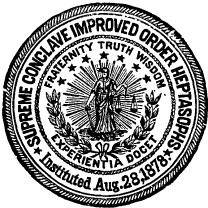 Ten
years after the Ancient Order of United Workmen launched its fraternal insurance
program in 1868, the Improved Order of Heptasophs was organized on August 10,
1878. Judge George V. Metzel is commonly agreed to have been the order’s
founder.
Ten
years after the Ancient Order of United Workmen launched its fraternal insurance
program in 1868, the Improved Order of Heptasophs was organized on August 10,
1878. Judge George V. Metzel is commonly agreed to have been the order’s
founder.Improved Order of
Heptasophs
 Ten
years after the Ancient Order of United Workmen launched its fraternal insurance
program in 1868, the Improved Order of Heptasophs was organized on August 10,
1878. Judge George V. Metzel is commonly agreed to have been the order’s
founder.
Ten
years after the Ancient Order of United Workmen launched its fraternal insurance
program in 1868, the Improved Order of Heptasophs was organized on August 10,
1878. Judge George V. Metzel is commonly agreed to have been the order’s
founder.
The IOH began as a schismatic group, separating itself
from the parent order, the Order of the Heptasophs,
founded in 1852. The parent order was conservative and cautious relative to
entering fraternal benevolent insurance programs. This posture made some members
unhappy and so they formed an independent group, the Improved Order of
Heptasophs. At first the IOH received considerable opposition from the parent
order, which retarded the growth of the IOH. Eventually, however, the tension
between the two societies subsided, and the IOH grew rapidly. By 1915 it had
676,887 members, about the most members the society ever had.
As other fraternal benefit societies were accustomed to
doing some seventy years ago, the IOH also employed the assessment plan in
collecting funds for its life insurance (death benefits). During the 1890s the
order’s death benefits ranged from $1,000 to $5,000. The IOH was one of the
first fraternal benefit societies to place its insurance operations under state
insurance departments.
Initially, the IOH operated on three levels, but after
a few years of experiencing a three-level structure, it disbanded the state
level and retained only the “Subordinate Conclave” and the “Supreme
Conclave.” The society had its head office in Baltimore, Maryland. In May of
1917 the IOH ceased to exist when it merged with the Fraternal Aid Union. The
latter changed to Standard Life Association in 1933.